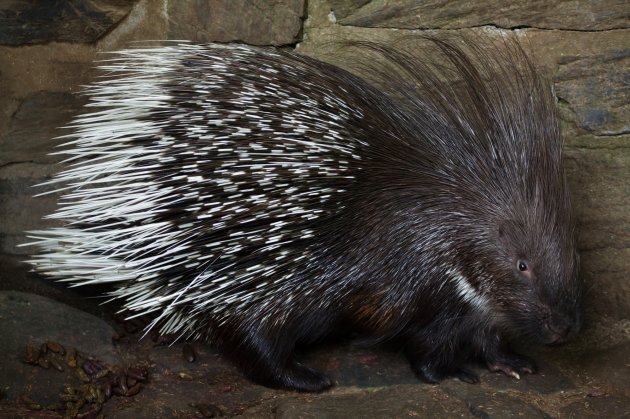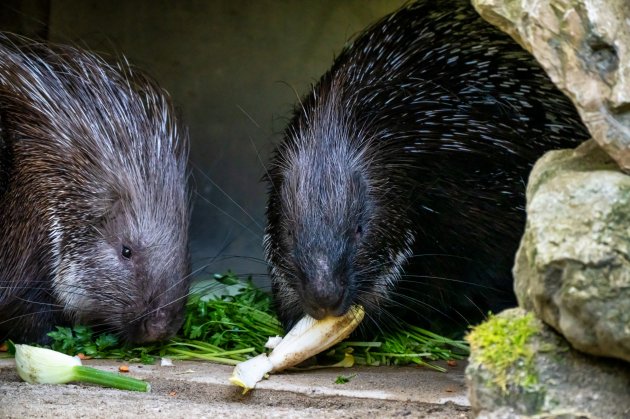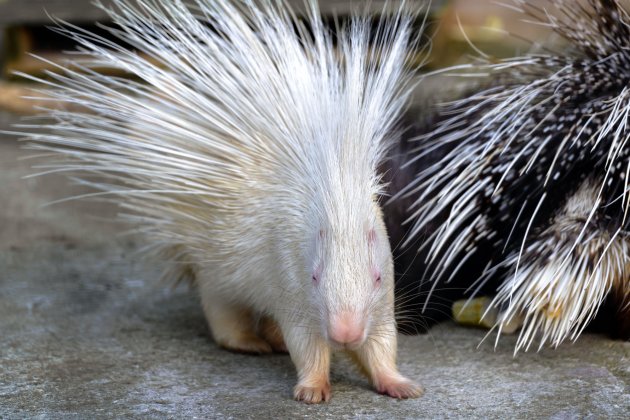In the realm of exotic pets, the porcupine may be one of the oddest. However, believe it or not, some folks do keep this prickly pet in their homes.
You may be wondering, “what about the quills?”
Even though this animal does have a spiky defense mechanism, pet parents of this rodent have learned how to work around them.
If you think this animal is the right one for you, read on for some important tips on keeping the porcupine as a pet.

The Appearance of the Porcupine
Even though there are 29 species of the porcupine, the one most commonly kept as a pet is the North American porcupine (it is also the largest).
This species has black to brownish-yellow fur under sharp quills (which are modified hollow hairs with a solid base and a solid, sharp barbed tip). Porcupines can have up to 30,000 quills on their stocky bodies. The quills cover its entire body (longest on the rump, shortest on cheeks) except for its tummy where there is only fur.
The porcupine also has a small head, small ears, and hairless soles on its feet which enable it to climb trees. The front feet are equipped with four “fingers” on the front feet and five on the hind feet.
Porcupine Fast Facts
- Weight: Up to 20 pounds
- Length: 2 to 3 feet
- Lifespan: Up to 30 years
The Behavior of the Porcupine
In the wild, porcupines are relatively solitary animals, coming together during the breeding season or to den together during cold wintery weather. They do not hibernate but will stay “indoors” during inclement weather.
They can be found lounging in caves, dens, tree hollows, and decaying logs. The North American porcupine is an excellent swimmer using its many hollow quills to keep it afloat.
This porcupine is also an excellent climber and spends the majority of its time in the trees. It can even make a variety of sounds like wails, moans, teeth clicking, coughs, grunts, and shrieks.
Housing the Porcupine
Keeping a porcupine in your home is going to take some planning. You will need a large enclosure with minimum measurements of five feet wide by five feet long by eight feet high - arboreal porcupines (those that spend most of their time in trees) need an enclosure that is tall rather than long. Line the enclosure with straw or wood shavings, as it will need to be cleaned every day.
The enclosure should also contain plenty of logs, branches, and wood stalks to help mimic their natural environment.
If you choose to house your pet porcupine outdoors, be sure the enclosure is well-ventilated and protects them from the elements, extreme heat, and cold.

Feeding & Caring For a Porcupine
In the wild, the North American porcupine dines on roots, berries, twigs, stems, and other vegetation. In the winter, it mainly eats conifer needles and tree bark.
Porcupines can be a bit fussy when there is plenty of food available (taking a bite and moving on to something different). In captivity, provide your pet with mainly fruits and veggies, with a rodent pellet supplement.
Feed your porcupine twice a day, with a fruit or veggies snack in between. Apples are a favorite of this animal, as well as yellow pumpkins and corn on the cob.
This animal will also need a bit of salt sprinkled on its food as a supplement.
Lastly, since the porcupine’s teeth never stop growing, you will have to provide it with chew toys or natural wood items like birch or willow branches. You can also use beef bones (like those for a dog), which is also a good source of calcium.
Use stainless steel or ceramic dishes to provide fresh water for your porcupine (this will prevent it from chewing through the container).
Handling a Porcupine
Unlike other pets, the porcupine should definitely come with a “handle with care,” label. Because this animal is covered in quills, you won’t be able to scoop it up and hug it.
The porcupine should never be startled or snuck upon, as this will make it defensive and you risk injury. Pet parents should only handle the porcupine while wearing thick leather gloves.
It’s always best to have the porcupine come to you while in a sitting position on the floor. Once the porcupine is comfortable with your presence, slowly reach out and scratch it on the top of the head.
Building a friendship with a porcupine takes time and patience. Use food rewards, gentle talk, and slow movements to help forge a healthy and loving relationship with this animal.
Note: Due to its nature (and its quills), the porcupine should not be housed with other animals.

Fun Porcupine Facts
Want to learn more about this exotic pet? Check out these fun porcupine facts!
- Porcupines are the third largest rodent in the world.
- This animal cannot throw its quills, it’s a myth. When it feels threatened it will swat its tail at the attacker, leaving its quills in the face or body.
- Old World Porcupines live in Asia, Africa, and Southern Europe
- The quills of the porcupine are pre-medicated with an antibiotic. This keeps it from getting an infection from an accidental self-quilling.
- Baby porcupines are born with soft quills. They harden up within a few days after birth.
- The quill has overlapping barbs (up to 800) on each tip.
- Porcupines have a natural “musky” smell.
- This animal is more active at night.
- Baby porcupines are called “porcupettes”
The Porcupine & You
If you think the porcupine is the right pet for you, be sure to check with your city’s bylaws to ensure it is legal to own one.
Never take a porcupine out of the wild as this is very traumatizing to the animal which can cause illness and even death. If you find an abandoned baby porcupine, call a wildlife rescue to come and get it.
Before you bring a porcupine home, be sure you are fully prepared for the responsibility this exotic animal brings. Do your homework, so you can provide your pet porcupine with the best life possible.
References and further reading:
- Allison Keating. Quirks & Quills! Understanding Porcupines.
- Anne Trafton, MIT News Office. Inspiration from a porcupine’s quills
- Uldis Roze. (July 15, 2009). The North American Porcupine
- Uldis Roze. (October 12, 2012). Porcupines (The Animal Answer Guides: Q&A for the Curious Naturalist)